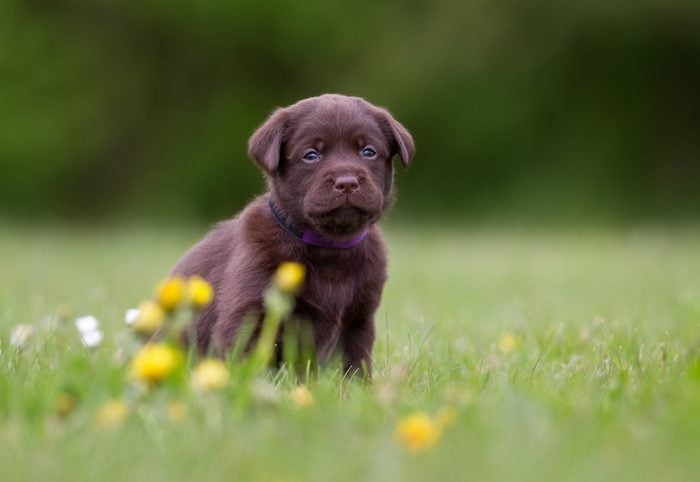
You rush inside after puppy does his business
“If he enjoys being outside to sniff and explore, it won’t take him long to learn that as soon as he pees, the fun is over. As a result, you may end up with a dog who avoids going to the bathroom when he’s outside until he absolutely has to,” says Jennifer L. Summerfield, Brown Veterinary Service, DVM, CPDT-KA and author of Train Your Dog Now! This can create problems down the line for those inevitable times when you really are in a hurry and need him to go quickly. Do this instead: take your pup out on a leash and wait patiently until he does his business. “After, praise and reward him and go for a walk or have some playtime in the yard. This way, he’ll learn to go promptly as soon as you take him out,” Dr. Summerfield says.
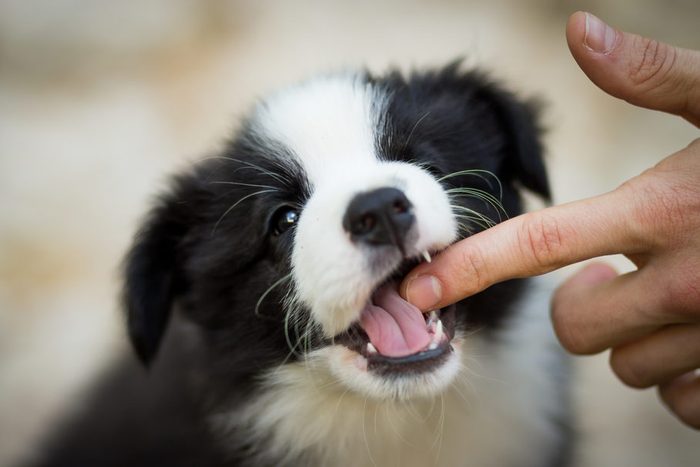
You let your puppy give you love nips
Puppies use their teeth to explore the same way a toddler uses their hands. “Expect them to put their teeth on everything, all the time, when they get excited,” Dr. Summerfield says. Encouraging little nips while horsing around may not seem like a big deal now, but it’s not something you want to feel when your pup is full grown. Try this—redirect your puppy to one of her toys whenever she starts to bite. “Praise him for biting and tugging on appropriate objects and reward him by continuing the game,” advises Dr. Summerfield. Puppyhood doesn’t last long enough; get your fix by looking at 50 of the cutest puppies.
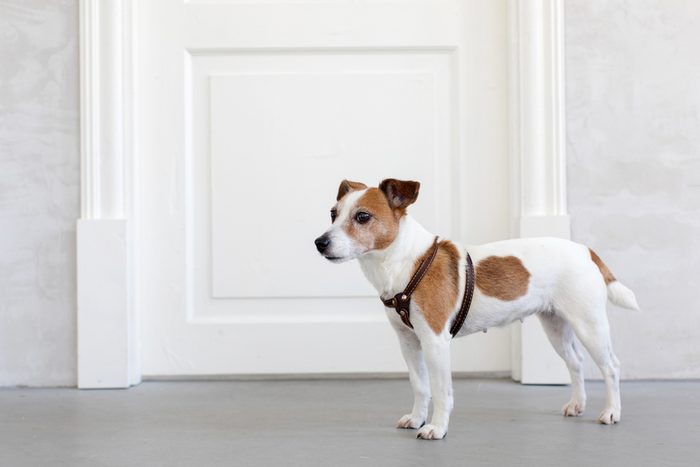
You get way too excited when someone is at the door
It’s fun to share the excitement of friends or pizza arriving at the door but when you psyche up your pup and rush to the door or excitedly ask, “Who’s at the door?” it can lead to bad habits like rushing the door, jumping on guests, or your pup escaping down the street and potentially compromising her safety. Here’s what Summerfield says to do: “Keep greetings low-key from the beginning and teach your puppy how to be polite when people come to visit. Put him on-leash before visitors enter, and praise and reward with treats for as he stays beside you.” Or teach her to go to her bed whenever the doorbell rings and give her a tasty treat for staying until the excitement dies down. Find out the 15 secrets dog trainers won’t tell you for free.
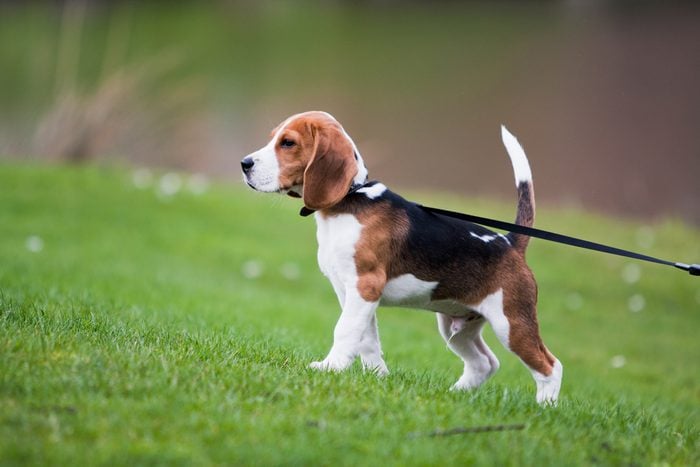
Allowing your puppy to pull during leash training
Dogs do what works for them so if you allow pulling in puppyhood, that’s what she will do now and forever, even when she’s a much, much bigger dog. Walks won’t be much fun and your shoulders and back won’t benefit from it either. Put your best foot and paws forward by teaching your puppy from the start that a loose leash earns great things—like treats, praise, and continuing the fun walk. But when the pulling starts, immediately stop. “If you’re consistent, she’ll learn to walk politely instead of bulldozing forward with you in tow,” says Dr. Summerfield. By the way, this is how much time your dog needs to walk every day.
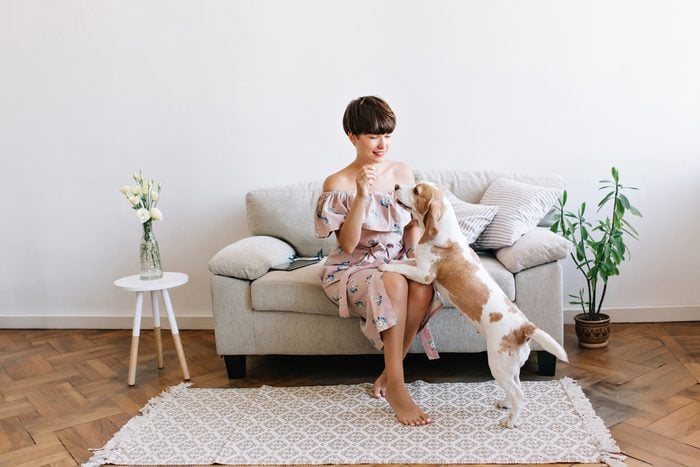
You let puppy jump up on people
You’re excited to see a cute puppy and the puppy is excited to see you. Puppies are generally small, so the mode for sharing affection and kisses is jumping. “But remember that if jumping up is ok now, he’ll assume it’s still ok later on when he weighs 80 pounds and can knock people down with his enthusiasm,” cautions Dr. Summerfield. Teach your pup to keep all four paws on the floor. “You can do this by scattering treats on the ground to keep him busy whenever he meets someone new, or train him to sit politely before being petted,” says Dr. Summerfield. These are the pet etiquette rules dog owners need to memorize.
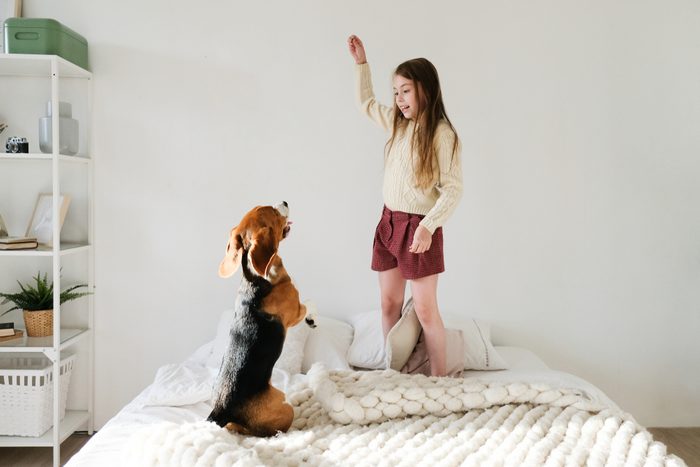
Your puppy doesn’t understand your cue words
You can’t expect your pup to learn obedience commands when you use different cue words for different behaviors, “like teaching your dog to ‘lay down’ but also saying ‘down’ when your puppy jumps up on you,” says Nick Hof, certified professional dog trainer and canine behavior consultant at Paws Look Listen. Do this instead: “Create a list of all the behaviors you’re teaching your puppy and keep it on the fridge so all family members can be on the same page. Try to keep each new one different sounding from the others so that it is as easy as possible for your puppy to learn the difference,” advises Hof. Even the most obedient dogs do weird things. Here are the reasons why dogs do things like roll around in stinky stuff.
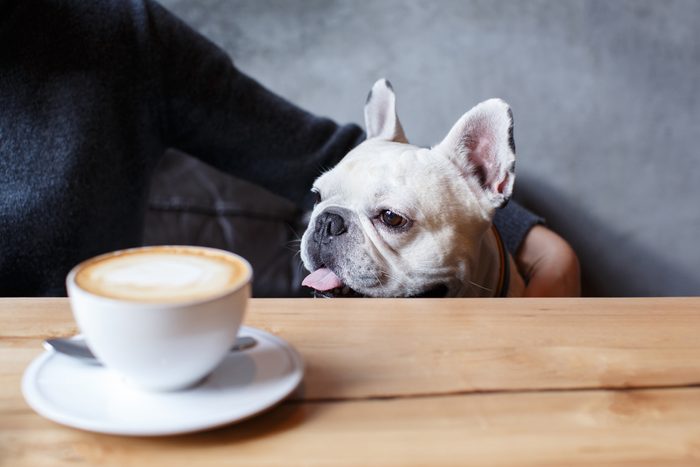
You feed her from the table
How can you resist those longing eyes looking up at you while you stuff your face? When you start feeding him from the table, he will expect it each time. And what happens when the begging becomes audible and he whines and barks until he gets what he wants? Change the reservation to humans only and give your pup an alternative behavior to keep him happy and occupied. “You could have your puppy in his crate, so you don’t have to worry, or you could practice teaching your puppy to stay on his bed. Couple this with a tasty chewy snack, such as a bully stick or stuffed Kong, and you have a recipe for success for years to come,” says Hof.
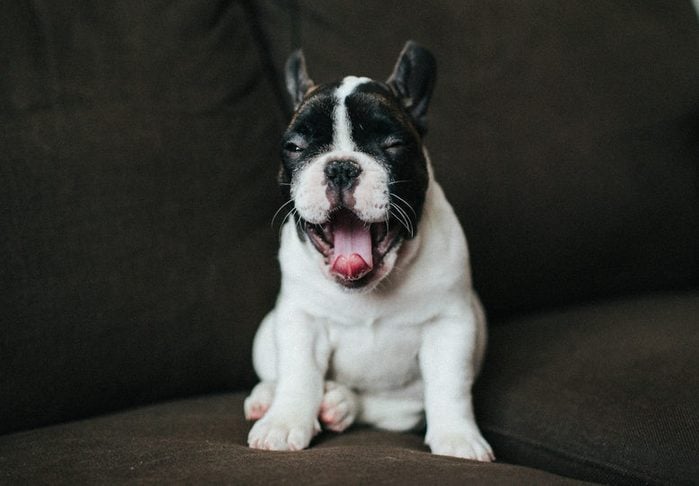
You don’t set boundaries
Your pup could literally run free without them. “A puppy who runs out the door or jumps on the couch without waiting for your invitation is a puppy who isn’t looking to you for direction and may even hurt themselves in their excitement,” says Hof. “Use everyday opportunities for the things that your puppy wants as opportunities to practice impulse control and reinforce your puppy’s manners,” suggests Hof. Using the door example, have your pup practice “sit” until released to go out the door. “By teaching them to say please some of the time, you are opening up communication with your puppy and showing them how to grow into a great dog.”
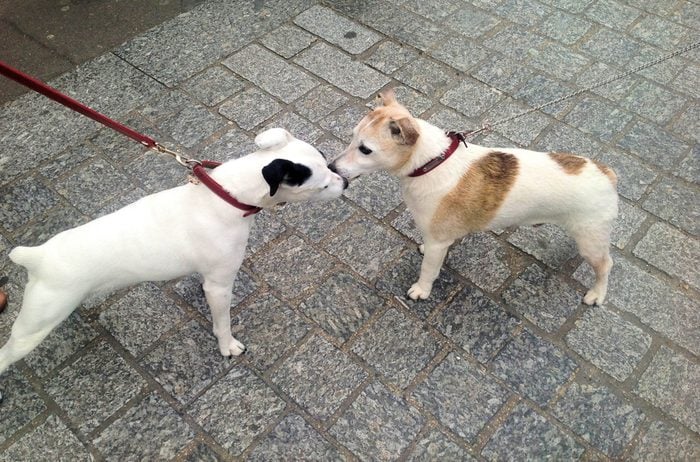
You keep your puppy all to yourself
It’s essential that you expose your pup to novel experiences like meeting new people, other dogs, pets, and going new places. If you don’t, your puppy will lack confidence which manifests as fear, aggression, and nervousness with people, dogs, and new situations. Socialization is essential early on—from three to 14 weeks, Hof says. Vaccinations are critical, so your pup doesn’t get sick when meeting other pups. “A good puppy training class is a great start. Also, look to take your puppy to non-dog places (The Home Depot, Gap) that allow dogs for socializing,” says Hof. Keep treats at the ready and never force your pup into a scary situation.
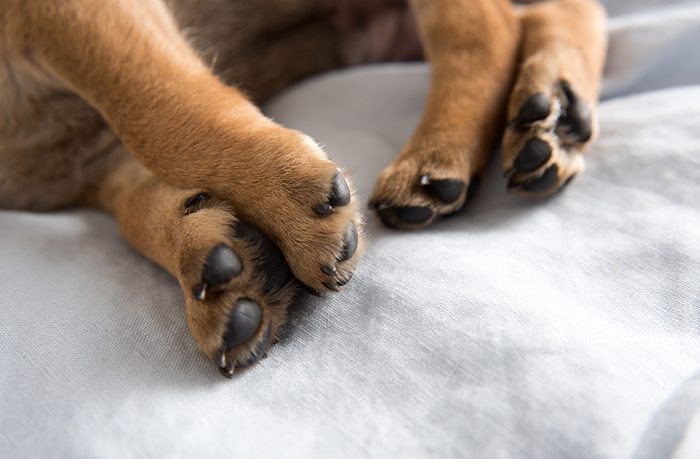
You give up on nail clipping
Nail clippers can be a scary thing for a young pup, but there’s no need to get this routine handled by your vet instead of clipping your puppy’s nails at home just because she whined, barked, or ran when you tried before. “When the puppy is young, handle the paws and give a treat. If the puppy fights you handling the paw, be patient and wait until the puppy stops struggling before releasing the paw. You can also use an electric toothbrush to mimic toenail clippings,” says Khara Schuetzner, certified professional dog trainer with Doggie Spot. Let her investigate it and turn it on near the paw and give her a treat. Work up to holding the toothbrush on the paw while treating. Grooming is just one of the many expenses of owning a dog. Here’s the cost breakdown to owning a pup.
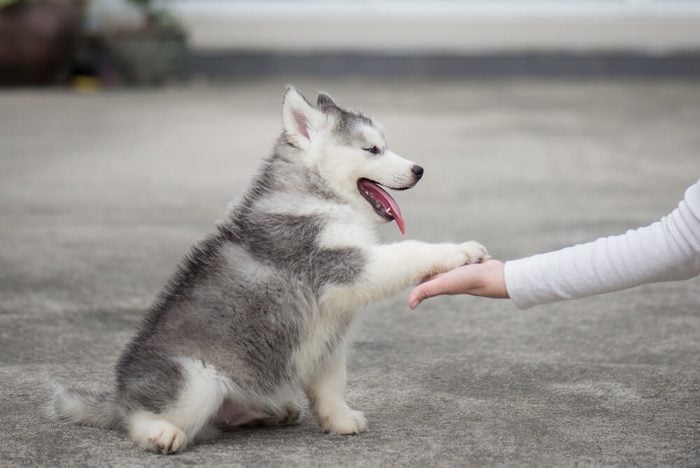
You forget your pup is always learning
Training isn’t just for puppyhood; things like discomfort with grooming, veterinary procedures, possessiveness of food and objects, or fear of novelty can develop later so don’t ease off on teaching socialization exercises. “Break each procedure down into smaller components and make each one predictive of something fabulous for your puppy,” says Jessica Ring, professional dog trainer and owner of My Fantastic Friend. For example, paw restraint is one component of nail trims. Gently hold your puppy’s paw and then give a yummy treat. For possessiveness issues, “Teach your puppy that it’s great when you approach them when they have food, toys, or chew objects. When your puppy has a chew toy or food, walk up and drop a tasty treat,” says Ring.
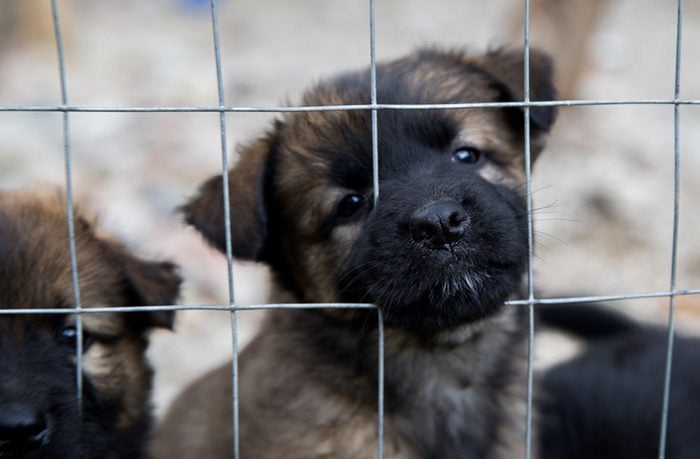
You rush to her crate when she whines
Each time you rush to the crate when she whimpers or barks, she learns you will rush to comfort her, and she may have trouble being alone later on. Do this instead: “Come and go frequently for very short periods. Wait for quiet before you return or let him out of his crate. Give him a safe toy, chew, or food-stuffed Kong or Toppl, so he has something to do,” says Ring. And make sure she has plenty of exercise and mental stimulation, so she’s not full of pent-up energy when she goes into the crate. Once she graduates from the crate here are some smart ways to keep her busy while she’s home alone.
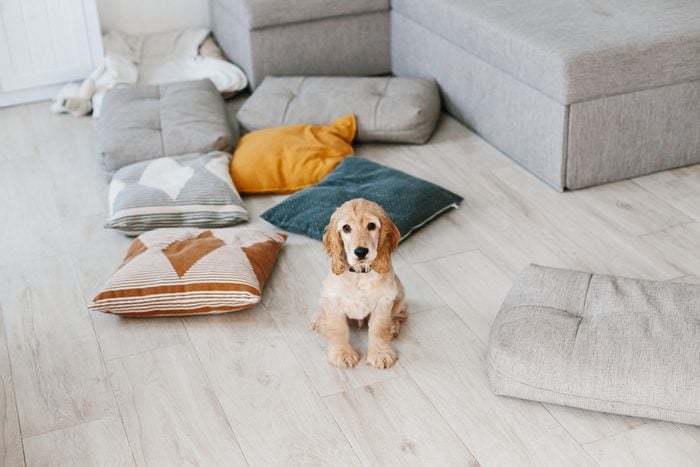
You let your puppy free roam
Your puppy discovers an amusement park of fun with so many sofa pillows to tear apart, shoes to poop in, and toilet paper to unravel when he’s allowed to roam the house unsupervised freely. Sorry, but the blame is all on you; puppies don’t know any better. It’s time to puppy-proof. “Keep your puppy in one puppy-proofed room under your supervision. If you have to take your eyes off of him, confine him using a crate or block off a small area with an exercise pen, or gate,” suggests Ring. Furnish the puppy space with chew toys, soft bed, an old shirt that has your scent, and toys for mental exercise like interactive balls that dispense treats. Next, read on to make sure you’re not guilty of doing these 14 things your dog actually hates.